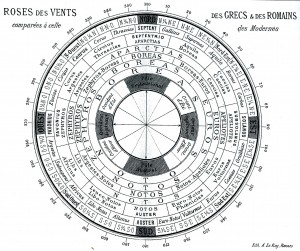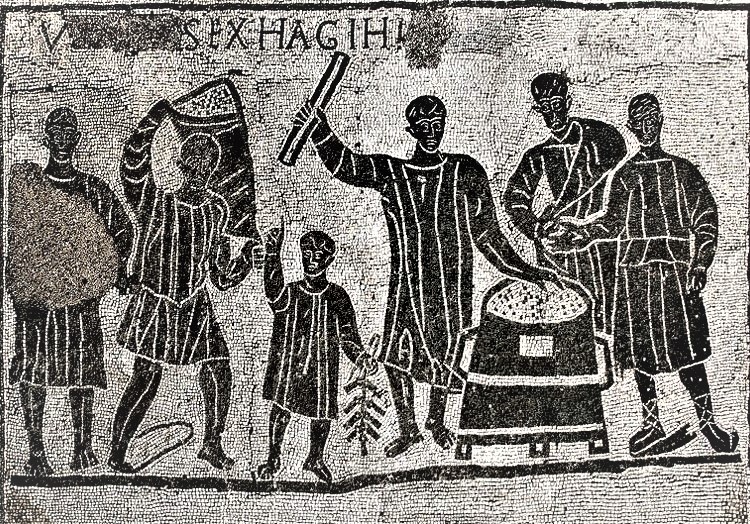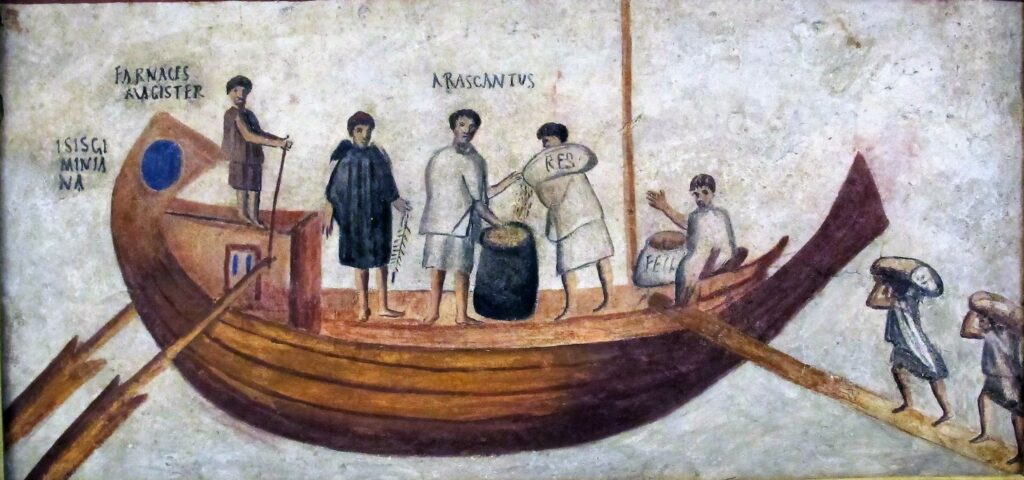The Greeks had a coherent system for short distances which was inherited from the Egyptians and transmitted to the Romans:
- one Greek finger, daktylos: 19.25 mm, a Roman finger is 18.50 mm and an Egyptian finger is 18.75 mm
- one Greek palm, palaiste: 77 mm, a Roman palm is 74 mm and an Egyptian palm is 75 mm (4 fingers)
- one Greek foot, pous: 0.308 m, a Roman foot is 0.296 m and an Egyptian foot is 0.300 m (16 fingers)
- one Greek cubit, pechos: 0.462 m, a Roman cubit is 0.444 m (24 fingers, 1.5 feet), but an Egyptian royal cubit is 0.525 m (28 fingers, 7/4 of a foot)
- one Greek step, bema: 0.77 m and a Roman step is 0.74 m (2.5 feet)
- one Greek pace: 1.54 m and a Roman pace, passus is 1.48 m (5 feet)
- one Greek fathom, orguia, orgye: 1.85 m (6 feet, 4 cubits)
- one Greek pleather, plethron: 30.8 m (100 feet, 40 steps), but also an area of 100 x 100 pleather: ca. 950 m2
The most commonly used unit for sailing distances was the stadium, but before the Romans put some order into it, there was much confusion on the length of an ancient stadium:
- one Athens stadium is 240 Greek steps, 600 Greek feet; this unit was used for the Roman stadium: 185 m, note this value is also equal to 1/10 nautical mile (or 1/10 of a minute of latitude[1]); it is still in use today as a ‘cable’. This unit was used by Pliny and by Strabo.
- one Delphi stadium: 177.7 m (used by Strabo and by Polybius)
- one Olympia stadium: 192.3 m (also used by Strabo)
- one Egyptian stadium: 157.5 m (used by Eratosthenes and by Arrian)
A Roman mile is 1480 m (8 Roman stadia, or 1000 Roman paces, or 2000 Roman steps, or 5000 Roman feet).
In times without any charts, the measure of distances at sea was focussed on the time needed to sail a given distance and sailors used the ‘day of navigation’ of a sailing cargo ship. They nevertheless had a few averaged benchmarks:
- 1 day of navigation (12 to 17 hours)[2]: 500 to 700 stadia (50 to 70 nautical miles).
- 1 day and 1 night (24 hours): around 1000 stadia (100 nautical miles).
This yields an average speed of around 4 knots (4 nautical miles/hour, 7.4 km/h).
For a trireme of the 5th c. BC, an average speed of 5 knots is accepted for a duration of 10 to 15 hours/day. Under sail, these ships were a bit slower than under oar[3].
More information on the origin of time measurement by Vincent Boqueho (2021).
.

.
Wind directions are defined according to their origin: to sail eastward, you are pushed by a western wind (“westerlies”), typically like the Zephyr which leads to Alexandria (where they call it the “etesian winds” or “summer winds”) if you leave from … Zephyrion Acra (modern Capo Bruzzano, in Calabria). A stable wind direction could therefore be used as a guide, but a rose with more than 8 directions has little practical value for an ancient sailor.
“If a man does not know to which port he is steering,
no wind is favorable to him”
(Seneca, Epistolae, 71, 3… but one might not agree…).
Other important units are:
- one Roman talent : mass of ca. 33 kg (60 Roman minae, or 100 Roman libra) but a Greek talent is only 26 kg. It is also a currency: a Greek talent of silver is 6000 Greek drachmas, or 36 000 Greek obols, or 24 000 Roman sesterces; but an Egyptian talent is only 6000 Roman sesterces.
- One sesterce: 10 €, based on the fairly low annual salary of a 1st century soldier or worker of 1000 sesterces/year[5], compared to the French lowest revenue (RSA) of 6 720 €/year and to the netto minimum legal wage (SMIC) of 14 500 €/year in 2019 for a single man.
Similarly, one ‘denarius communis’ from Diocletian’s Price Edict is worth around 1.5 €. - amphora quadrantal: as a volume for liquids, one amphora is one Roman cubic foot (nearly one modern cubic foot) = 2 modii castrensis = 3 Italic modii = 8 congii = 48 sextarii, or around 26 litres. A full Dressel 1B amphora of the 1st c. BC weights around 50 kg (olive oil, wine, fish brine), out of which around half is tare. However, an empty 1st c. AD Gauloise 4 amphora from Narbonensis weights only ca. 10 kg and holds 30 to 38 litres because its wall is thinner. One Greek metretes was around 39 litres (1.5 amphorae).
- For dry bulk like grain, in Egypt, the Greeks used a larger unit of 52 liters (2 amphorae) called Ptolemaic medimnos weighting 40 kg when filled with wheat (dry wheat weights 780 kg/m3). It may be noted that Egyptian wheat was transported in sacks of one Ptolemaic artaba (ca. 39 litres) with a unit weight of ca. 30 kg. The Romans also commonly used the modius (1/3 of an amphora, or ca. 8.6 litres, or ca. 6.7 kg of wheat), hence one artaba is 4.5 modii, and 150 modii of wheat is one ton[6].
- Note also that wooden oak barrels (500 to 1000 litres) took over from amphorae (and dolia) for storage of wine during the Roman Empire.

(source & explanation: https://www.ostia-antica.org/regio1/19/19-1.htm ).

.
Notes
[1] Eratosthenes (276-194 BC) already estimated the terrestrial meridian at 250 000 Egyptian stadia, that is 39 375 km. The circumference of the Earth being 360 x 60 = 21 600 minutes of latitude or as many nautical miles, one nautical mile therefore is 1823 m for Eratosthenes, which is remarkably close to today’s value of 1852 m.
To find this remarkable result, Eratosthenes measured the distance between Syene and Alexandria (he found 5 000 stadia) and estimated this at 1/50 of the earth’s circumference from his famous experiment with a gnomon, based on the location of Syene exactly on the Tropic of Cancer. Note that the north-south distance between Syene and Alexandria is 790 km, leading to 158 m for one stadion and confirming Eratosthenes used Egyptian stadia of 157.5 m.
Eratosthenes also estimated the distance between Rhodes and Alexandria at 3 750 Egyptian stadia (acc. to Strabo, Geogr, 2, 5) that is 591 km, almost exactly what we would say today based on Google Earth (600 km from Mandraki to Pharos). It can be noted that Ptolemy (350 years later) will be heavily mistaken on these figures.
[2] A “long day” probably refers to a summer solstice day (Arnaud, 2014), that is 13.5 hours in Berenike Troglodytika, 14.0 hr in Alexandria, 15.0 hr in Istanbul, 15.6 hr in Aquileia, 16.0 hr in Paris.
[3] MORRISON, J.S.; COATES J.F.; RANKOV, N.B., 2000, “The Athenian Trireme”, Cambridge University Press.
[4] VARS, J., 1887, “L’art nautique dans l’antiquité et spécialement en Grèce”, Paris.
[5] Salary of one denarius = 4 sesterces = 16 asses per day, acc. to Tacitus, Annals, I, 17, and on 250 days/year, i.e. 1000 sesterces/year (around 110 AD). Note that before 140 BC one denarius = 4 sesterces = only 10 asses.
270 years before Tacitus, Cato tells us in his De Agricultura, 22, 3 (around 160 BC) that “the charge for transportation by oxen, with six days’ wages of six men, drivers included, is 72 sesterces”, that is 2 sesterces or 0.5 denarius per man-day.
Inflation might thus be estimated as follows from the cost of one labourer’s man-day: ca. 0.5 denarius in 160 BC; 1 denarius in 110 AD; 4 denarii in 240 AD; 25 denarii in 301 AD in Diocletian’s Price Edict. The highest inflation rate (between 240 AD and 301 AD) is around 3% per annum.
See also: https://web.archive.org/web/20130210071801/http://dougsmith.ancients.info/worth.html
[6] The Romans reduced the value of one artaba to that of an amphora (ca. 26 litres) but the Ptolemaic artaba of 39 litres survived even after the end of the Roman empire.
DUNCAN-JONES, R., 1976, “The Choenix, the Artaba, and the Modius”, Zeitschrift für Papyrologie und Epigraphik, 21, (p 43–52) (https://www.jstor.org/stable/20181077).
NANTET, E., 2017, “Combien pouvait-il transporter ? Mesurer le tonnage d’un navire n’est pas une simple affaire”, in: Dialogues d’histoire ancienne, supplément n°12, 2014, (p 201-210).
LUND, J., 2023, “Speaking volumes. On the Capacities of Transport Amphorae from the Hellenistic Period through to Late Antiquity”, in “Regional Economies in Action. Standardization of Transport Amphorae in the Roman and Byzantine Mediterranean”, Österreichihes Archäologisches Institut Sonderschriften 65, Wien, (p 43-56).
FAO, 2015, “Base de données FAO/INFOODS sur la densité”, Version 2.0.